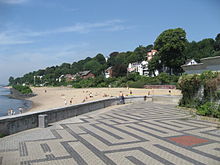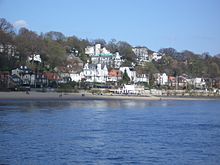Övelgönne
Övelgönne (also Oevelgönne ) was a rural community in the Pinneberg district until 1890 , a district of Altona until 1938 and has been part of the Hamburg district of Othmarschen since then .
Surname
The name of the district means "evil favor" and refers either to the dodgy attitude of the first residents or to the poor buildability of the area. According to another tradition, the name comes from “Übel Gegönnt” (övel gönnt) and indicates the resentment of the Ottensen population towards the Övel patrons. Due to their residential location close to the river, they had the opportunity to acquire valuable flotsam that the Elbe released before anyone else. There has been a dispute about the correct spelling for many years. “Oevelgönne” and “Övelgönne” are up for discussion.
Today this is only used to describe the corresponding section of the Elbe beach in Hamburg, downstream from the Oevelgönne museum harbor at the Neumühlen pier , and the narrow pedestrian path lined with numerous old houses, some of which are several hundred years old and were inhabited by pilots and ship captains for a long time . From the Övelgönne pedestrian path, a staircase called the "Himmelsleiter" leads with 126 steps from the Elbe glacial valley up the Geest slope to the Elbchaussee above .
history
In 1674, Övelgönne was first mentioned in the church book of the Ottensen community, to which the place belonged. In 1731 Övelgönne became independent and after the formation of the districts in Schleswig-Holstein in 1867 came to the district of Pinneberg, to which it belonged until it was incorporated into the independent city of Altona in 1890.
In the years 1925/26 there was a water airport for the first German seaplane line below Schröder's Elbpark on Övelgönner Hohlweg . During that time, Junkers F 13 operated twice a day on the Altona – Dresden seaplane route with a stopover in Magdeburg.
There used to be shipyards on Övelgönner Strand , which today are only visible when the water is low and the logs used to lower the ships into the water.
Museum harbor
Övelgönne is also home to the Oevelgönne museum harbor with the exhibition of historical watercraft. Due to the planned collaboration with Hamburg museums, the term museum harbor prevailed when the association was founded. The Museumshafen Oevelgönne eV is the oldest privately owned museum harbor in Germany. Some ships are club owned. The aim is to maintain watercraft, such as the sailing fishing and freight vehicles from the Lower Elbe as well as from the North and Baltic Sea region ( Cutter , Ewer and Tjalken ), port vehicles moving under steam ( tugs ), service vehicles with motor drive (police, customs, lightship ) and port handling technology (cranes and hoists). On the quay there are signs with information about the ships that are temporarily on site.
The New Elbe Tunnel runs between the museum harbor and the Elbe beach , recognizable by a ventilation structure, the central aerator structure .
Attractions
The beach is a popular destination for walking, jogging and barbecuing for the Hamburg population. Easter fires are lit there at Easter to welcome the summer. There is also the Cafe Strandperle , which has existed since the early 1970s and, according to the author Frank Rumpf, is the "mother of all inner-city beach clubs". It is also mentioned in the episode The River Pirate of the cult series Großstadtrevier and the book Holidays Forever by Christian Kracht and Eckhart Nickel .
On the Elbe beach there is a boulder called "The Old Swede" , which weighs 217 tons, is 19.7 meters in circumference and 4½ meters high. It was found during the dredging of the Lower Elbe and was recovered on October 23, 1999.
On January 13, 1745, the Pilot Brotherhood was founded in the Old Pilot's House , which looked after widows and orphans of deceased Elbe pilots . In 1801, the old pilot house was converted into an inn and, as it is still in operation today, is one of the oldest restaurants in Hamburg.
Övelgönne in literature and art
The Hamburg writer and painter Hans Leip (poet of Lili Marleen ) created a monument to Övelgönne in his novel Jan Himp und die kleine Brise . The painter Ali Schindehütte immortalized Övelgönne in his illustrated book The Children of Övelgönne .
Personalities
- Ernst Dreyer (1816–1899), Altona shipbuilder , ship owner, co-founder of the Altona Museum and the seaside resort of Westerland lived for a long time on his property "Dreyer's Lust" (on the Elbchaussee) in Övelgönne.
- Kurt Siemers (1873–1944), businessman, shipowner and banker, was born in Övelgönne.
- The writer Peter Rühmkorf also lived in Övelgönne for a long time , but because of his illness he moved to Schleswig-Holstein , where he spent his old age.
- The debut novel Wie die Wilden by the native Övelgönner author Jan Jepsen is a homage to his childhood on the Elbe beach.
- The chef Tim Mälzer ran his restaurant "The White House" on the border with Övelgönne, in Neumühlen .
- Ina von Grumbkow (1872–1942), travel writer
literature
- Dörte Nicolaisen / Johannes Spallek : Övelgönne / Neumühlen. Workbooks on the preservation of monuments in Hamburg No. 1 , Hans-Christians-Verlag, Hamburg 1975.
Web links
- Story (s) from Övelgönne and Neumühlen on: Oevelgoenne.de
Individual evidence
- ^ Oevelgönne 11: Spa architecture in an international style . In: hamburg.de , accessed on March 10, 2011.
- ↑ Elbe hiking trail . In: Hamburg Cultural Authority , accessed December 10, 2014.
- ↑ Dirk Hempel: 1925: By seaplane from Altona to Dresden. In: Hamburg Journal . Norddeutscher Rundfunk , February 12, 2019, accessed on February 10, 2020 .
- ↑ http://unser-altona.de/elbstrand-hamburg/
- ↑ Frank Rumpf: Hamburg's beach pearl: mother of all beach clubs . In: Die Welt , April 7, 2010.
- ↑ Jan Haarmeyer: "Old Swede" - the colossus from the cold . In: Hamburger Abendblatt , September 16, 2009.
- ↑ Gudrun Maurer: Legendary places in Hamburg: what happened where? Via Reise Verlag Klaus Scheddel, Berlin 2012, ISBN 978 3 935029 53 7 , page 100
Coordinates: 53 ° 33 ' N , 9 ° 54' E




